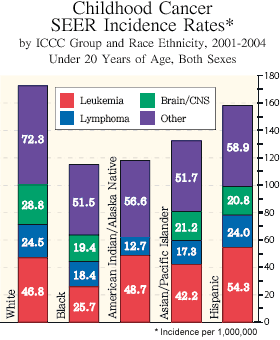
The very high cure rate in pediatric oncology has not been achieved without a cost: treatments that save children's lives can also damage developing organs, causing a wide array of health problems that may not surface for many years.
Current understanding of the extent of "late effects" in childhood cancer survivors - health problems related to cancer treatment that occur months to years after treatment ends - has emerged largely from the Childhood Cancer Survivors Study (CCSS). Since 1994, this NCI-funded research project has followed a cohort of 20,000 people who were diagnosed with cancer as children between 1970 and 1986 and survived at least 5 years.
In a study published in the New England Journal of Medicine in 2006, which looked at outcomes in more than 10,000 survivors, CCSS researchers found that almost two-thirds of patients reported at least one chronic health problem, one-quarter had a severe condition, and almost one-quarter had three or more chronic health problems. Late effects reported most frequently in this study were second cancers, cardiovascular disease, kidney disease, musculoskeletal conditions, and endocrine abnormalities. The risk of developing a health problem related to cancer treatment in childhood increased over time.
Women face higher risks than men for late effects including breast cancer, cognitive dysfunction, heart disease, and hypothyroidism. Other factors influencing late effects include age at diagnosis, type of cancer, and types of treatment received. Radiation treatment, especially to the brain - and, in women, the chest - carries a high risk of long-term effects.
"Both the magnitude and the diversity of the long-term health effects have been striking," says CCSS principal investigator Dr. Les Robison of St. Jude Children's Research Hospital in Memphis. "At 30 years after their diagnosis, more than 70 percent of childhood cancer survivors have a late-effect chronic health condition."
 Results from CCSS studies are now informing the development of guidelines for appropriate follow-up care for childhood cancer survivors, adds Dr. Robison. The limited data so far available suggest that most survivors do not receive the recommended follow-up care. CCSS researchers are now planning several new studies looking at how to ensure more survivors obtain follow-up care so that late effects are detected as early as possible.
Results from CCSS studies are now informing the development of guidelines for appropriate follow-up care for childhood cancer survivors, adds Dr. Robison. The limited data so far available suggest that most survivors do not receive the recommended follow-up care. CCSS researchers are now planning several new studies looking at how to ensure more survivors obtain follow-up care so that late effects are detected as early as possible.
CCSS data are available to researchers studying important questions in pediatric cancer survivorship through the St. Jude Web site (www.stjude.org/ccss). To date, the CCSS has generated more than 75 publications in the peer-reviewed literature.
Treatments for childhood cancer have changed a lot since the CCSS cohort was treated in the 1970s and early 1980s. To learn about the long-term effects of these newer therapies, researchers are now expanding the CCSS cohort by recruiting 20,000 survivors treated for childhood cancer between 1987 and 1999 who have survived at least 5 years.
In other efforts, researchers are developing new tools, such as the Passport for Care, to help clinicians and childhood cancer survivors be more aware of and communicate with each other about the long-term effects of cancer treatments, as well as decision aids to help survivors weigh the costs and benefits of treatment approaches.
"Childhood cancer survivors are in the vanguard in terms of our understanding of the impact of living long-term after cancer treatment," says Dr. Julia Rowland, director of NCI's Office of Cancer Survivorship. "The challenge is to ensure that they are appropriately followed across their lifetimes to minimize cancer's late adverse impacts and maximize these survivors' overall health."
|